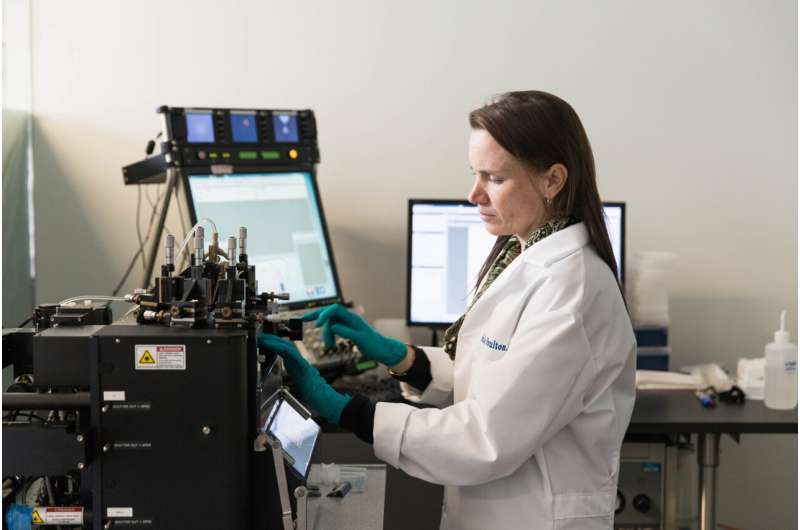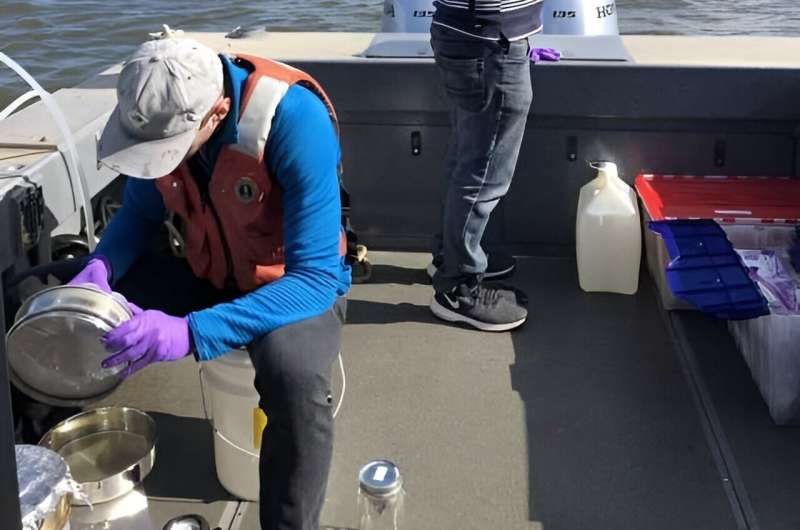This article has been reviewed according to Science X's editorial process and policies. Editors have highlighted the following attributes while ensuring the content's credibility:
fact-checked
trusted source
proofread
Scientists test new method for identifying small microplastics

Microplastics, from the beads that were once commonplace in cosmetics to the weathered and broken-down remnants of trash, are now ubiquitous in marine and inland waters around the world. To date, though, scientists have struggled to identify which plastics persist longest in the environment and measure their abundance, especially at the smaller end of the size range where they're most likely to be consumed by foundational species near the bottom of the food web, like zooplankton.
Researchers from Bigelow Laboratory for Ocean Sciences and the University of Minnesota Duluth have now developed an innovative analytical method that combines different specialized techniques, including flow cytometry, to characterize and count these small varieties of microplastics.
The team tested out the technique using water samples from Lake Superior, providing an important step toward future application of the method. The findings were published in the journal Limnology and Oceanography Methods.
"With this method, we're not just counting particles blindly or relying on mathematical models," said Bigelow Laboratory Senior Research Scientist Nicole Poulton, one of the study's co-authors. "We're actually able to determine how much plastic is present and what those plastics are."
Microplastics range from a fraction of the width of a hair to the length of a grain of rice and include all types of plastic compounds. These small particles are often mixed with harmful chemical additives, and they can cross sensitive biological barriers in the brain and gut. They can also act as sponges, absorbing and transporting pathogens and pollutants like oil.
The toxicity and environmental impact of these particles is a function both of how much there is and the type of microplastic, from its chemical composition to its size and shape. Scientists, however, rarely have all that information.
"Risk assessments of microplastics aren't focusing on the types and sizes of plastics that we think are actually most prevalent in the environment, partly because we're bad at measuring them," said Elizabeth Minor, a professor at the University of Minnesota Duluth and lead author of the new study.
In their new approach, the researchers first process the water samples to remove organic matter that could be confused for microplastic and infuse the samples with a dye called Nile red that stains plastic.
They then use a flow cytometer to line up the microscopic particles and hit each with a laser—at a rate of 100s of particles per second—that causes the stained microplastics to light up, allowing the researchers to separate them out from the rest of the sample. Flow cytometry is commonly used in the biomedical field, but Bigelow Laboratory's Center for Aquatic Cytometry, of which Poulton is the director, has played a critical role in expanding its use in environmental research.

For this study, the researchers used the flow cytometer at Bigelow Laboratory to isolate and measure individual microplastic particles, and then sent them to Minnesota to be further analyzed. Minor's lab used pyrolysis gas chromatography mass spectrometry, or pyGCMS, a popular tool for determining the chemical composition and total weight of plastic samples.
After refining the method in the lab, the researchers tested it out with natural samples of surface water from Lake Superior. They found that particles in the five to 45 micrometer size range were more abundant—by several orders of magnitude—than larger particles that could be easily measured with traditional methods. They also found both polyethylene and polypropylene, plastics that make up countless products from single-use plastic bags to textiles, an important first step for identifying sources of plastic pollution.
Contamination is a major challenge at each step given the prevalence of plastic in everything from lab equipment to clothing. Particles under five microns are still too small for researchers to confidently enumerate, as, for instance, the Nile red dye creates little solid precipitates that can be difficult to distinguish from the smallest bits of plastic.
Despite these limitations, though, the researchers' new method provides a more complete picture of both the amount and type of microplastics, in a smaller size range, than was previously possible. It also highlights the potential benefits of flow cytometry to rapidly count microplastics, which could help improve the real-world applicability of risk assessments.
"While people are really concerned about microplastics, we don't actually have a good handle on this problem yet," Minor said. "But we've hit this sweet spot with this new approach where we can start looking at things more accurately and in more detail."
More information: Elizabeth C. Minor et al, Small microplastic particles in Lake Superior: A preliminary study coupling Nile red staining, flow cytometry and pyrolysis gas chromatography–mass spectrometry, Limnology and Oceanography: Methods (2023). DOI: 10.1002/lom3.10582
Provided by Bigelow Laboratory for Ocean Sciences





















